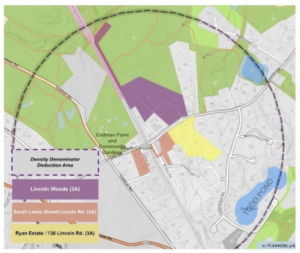By Barbara Peskin
This morning, I walked my dog at Harrington (a.k.a. Stonybrook) and saw an “E is Exclusionary” yard sign in the parking lot. I support Option E over C, not to be exclusionary, but because while it allows for significant HCA development in the Lincoln Station area, Option E doesn’t earmark all 39 parcels.
HCA developments will not create communities like the Lincoln Woods apartments; instead, construction will be three- and four-story high-end condo buildings. Option E also keeps wildlife and habitat around Codman Farm and gardens and along Codman Road less vulnerable. The map here compares the Option C and E parcel plans.
I compiled the parcel list and map at right to show which parcels are in Option E that are also in Option C. 2 Lewis St. was recently added to Option E. Once an HCA bylaw passes, development on HCA parcels can happen quickly, with only Planning Board site plan review.
Because Option C puts all 39 parcels into play for quick process development, a scenario like this could result:
- January 2, 2025 — Developer 1 begins construction of a 20-unit, three-story condo building at 152-154 Lincoln Rd. February 1, 2025. Developer 2 begins construction of a 30-unit condo building at 146/148 Lincoln Road.
- February 1, 2025 — Concurrently, Developer 3 begins construction of a 40-unit three-story condo building at 90 Codman Rd. and 26 units at 78 Codman Rd. When, how, and at what pace each of the 9 Codman Rd. parcels would be developed is unknown. HCA rezones for future development without a specific proposal in hand. We rezone any named HCA parcel for future by right development at any time. You can imagine the concern that has been expressed by some Codman Road residents who were not contacted prior to Option C and do not support the rezoning of their single home district. Some of us who often walk or bike ride Codman Road and cherish its habitat are concerned about the clear-cutting and impact on wildlife as well.
- March 1, 2025 — Developer 4 starts building at the mall and Doherty’s. They buy all six village center 25-units-per-acre parcels to build 170 units with multiple condo buildings plus some retail. They call the condo buildings next to Codman Farm and garden “Lincoln Gardens.”
- May 1, 2025 — Developer 5 closes a Codman/Lincoln/Lewis corner deal to purchase seven parcels: 72 and 74 Codman Rd., 168 Lincoln Rd., and four parcels on Lewis Street to build a 75-unit development on seven acres.
So far, in this scenario, 19 parcels would be redeveloped with three- to four-story condos and over 330 units, and we still have 20 more parcels to go. With Option C, we could have 19, 28 or even 39 different developers and projects all under construction at the same time.
Compare this to Option E, which has 14 parcels in the Lincoln Station area. The Select Board has said that if Option E is our choice on December 2, a parallel proposal to develop the mall will also be on the March Town Meeting warrant.
So Option E will result in significant redevelopment, yet leaves some of the other 25 Lincoln Station area parcels available for affordable housing development done at a pace we can anticipate and plan. The color coded map above shows the overlap of Option E with Option C.
Additional thoughts
- The state wants to know a town’s HCA districts by December 31, 2024.
- The Lincoln Select Board has decided that the town should vote on Lincoln’s HCA final solution at the March 2024 Town Meeting.
- The Select Board/HCAWG’s Options C and Ds include a village district (Doherty’s, mall, and four town-owned parcels) that would mix commercial with residential use. Since “mixed-use” isn’t strictly housing, and HCA is about housing, the state asks to review any “mixed-use” potential HCA district three months ahead of time.
- The three-month lead time specifically for mixed-use districts, along with Lincoln’s self-imposed March 2024 deadline instead of the state imposed December 2024 deadline, is what is pushing our option preliminary vote to the December 2, 2023 meeting.
- Option E does not include a mixed-use district and so does not require this additional lead time. If Option E is the choice of the town, we do not have to rush the decision.
- There is open-source software to model solutions. Lincoln Residents for Alternative Housing has modeled over 15 solutions, including Option E now on the December 2 slate of options.
- Our existing Lincoln zoned multifamily housing like Battle Road Farm and Lincoln Woods apartments have far more affordable housing than HCA guidelines require of developers.
Barbara Peskin is a member of Lincoln Residents for Alternative Housing.
“My Turn” is a forum for readers to offer their letters to the editor or views on any subject of interest to other Lincolnites. Submissions must be signed with the writer’s name and street address and sent via email to lincolnsquirrelnews@gmail.com. Items will be edited for punctuation, spelling, style, etc., and will be published at the discretion of the editor. Submissions containing personal attacks, errors of fact, or other inappropriate material will not be published.



